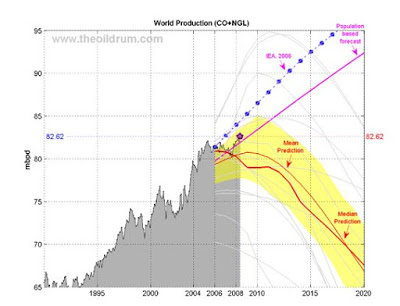A fundamental assumption of the study of economics is that human wants are unlimited.
The economic problem is human wants are unlimited, but the means to satisfy human wants are scarce.
The environmental problems the world faces are primarily because technologies of industry and energy are currently based on upgraded 18th and 19th century coal power.
Peak oil were wrong about oil limits but had insights into the relationship of energy to population
Until 1850, most of the world’s population was still supported by traditional renewables (wood, dung, etc.) and animal power, with minor amounts of wind and hydropower. In 1750, the world’s population was approximately 720 million people. Over the previous 1000 years, this population had been growing very slowly at an average rate of about 0.13 percent.
A projection from 2009, was trying to predict decline but showed that the population based energy demand matched closely with what was the 2015 result below
By 1850 population pressures led to the commercialization of coal and the Industrial Revolution, and the energy derived from coal began to shape the forces that would raise the population ceiling.
By 1900, coal was powering the entire world’s major industrial processes, and powering the industrial nations’ population growth.
Between 1800 and 1900, Europe’s population more than doubled from about 187 million to 400 million.
People will tend to choose more wealth and more of what they can afford
In previous articles, Nextbigfuture has gone into details as to why feeding 100 billion people on earth at the projected population growth rates is managable with simple technology like regular agricultural improvements and then greenhouses.
Nextbigfuture has also tracked various nuclear fusion projects and molten salt nuclear fission as well as uranium recovery from the ocean. Detailed analysis indicates that energy costs ten times less then now with one hundred to one thousand times the capacity is possible over the next few decades.
There has also been details around the trend to urbanization and megaurbanization. Megaurbanization is happening first in China and Asia but will also happen to certain degrees in western countries. Africa will likely follow the Asian model.
Megacities with 200 million people would have double the per capita income of cities with 5 million people.
People now can say, I do not need to go from $100,000 per person to $200,000 per person. But economics would say that more people are making the choice to go for more income.
There will be 4-6 megacities (megaregions) with over 100 million people by 2060-2080. There will be 5-12 megacities in 2100.
Technology will be able to resolve the problems around air pollution emissions and CO2 emissions.
From 2050-2100, there will be advanced nanotechnology and nuclear fusion.
There have been fairly simple analysis that the solar system could support 4,000 trillion humans by crude usage of the Asteroids comparable to the population of a million Earths. This could be ten thousand times more with usage of all material in the comet cloud. Energy from the sun via space based solar dyson swarms would easily provide everyone with power.
If population growth would did not slow from what is projected from 2009 to 2050.
Human Population in Billions
2009 6.8
2050 10.5
2090 16
2130 24
2170 36
2210 54
2250 81
2260 89
Annual population growth 1% less would be a population of 22 billion in 2260 and annual growth 1% high would be 360 billion.

Brian Wang is a Futurist Thought Leader and a popular Science blogger with 1 million readers per month. His blog Nextbigfuture.com is ranked #1 Science News Blog. It covers many disruptive technology and trends including Space, Robotics, Artificial Intelligence, Medicine, Anti-aging Biotechnology, and Nanotechnology.
Known for identifying cutting edge technologies, he is currently a Co-Founder of a startup and fundraiser for high potential early-stage companies. He is the Head of Research for Allocations for deep technology investments and an Angel Investor at Space Angels.
A frequent speaker at corporations, he has been a TEDx speaker, a Singularity University speaker and guest at numerous interviews for radio and podcasts. He is open to public speaking and advising engagements.




